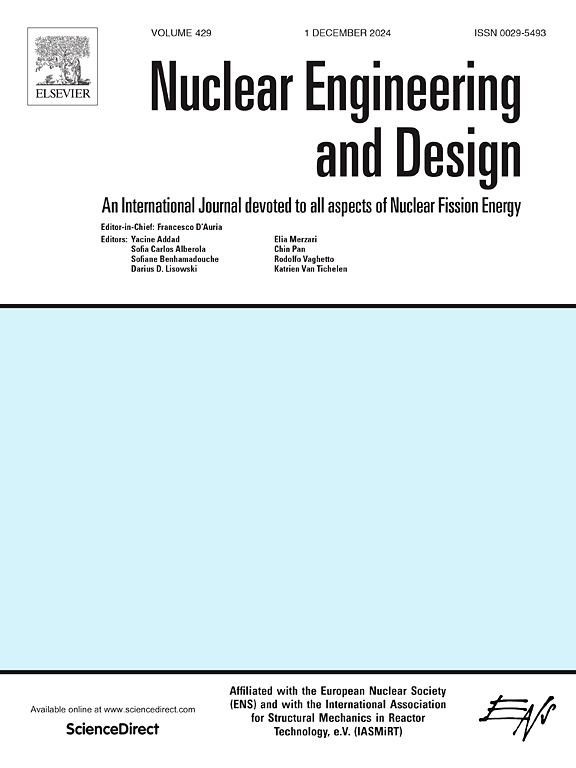偏高岭土基钾地聚合物固化磷酸三丁酯/十二烷废物
IF 1.9
3区 工程技术
Q1 NUCLEAR SCIENCE & TECHNOLOGY
引用次数: 0
摘要
放射性磷酸三丁酯/十二烷(TBP/十二烷)废物的处理是核工业中的一个真正的挑战。事实上,TBP/十二烷混合物是一种放射性液体有机废物,目前没有足够的或工业上成熟的解决方案来处理它。为了解决这一问题,本研究对偏高岭土(MK)基钾地聚合物在TBP/十二烷固化中的潜力进行了研究。这需要添加表面活性剂,以使生产的废液具有所需的流变性、机械性和微观结构特性。对三种表面活性剂进行了测试,发现brijo10在乳化和初始新鲜稳定性方面是最有效的。结果表明,使用mk基钾地聚合物粘结剂与Brij O10结合是一种潜在可行的方案,可以提供良好的乳液和易性和硬化前后稳定的整体复合材料。此外,在力学性能方面(必须保持在8mpa以上才能达到工业储存规格),本研究证实了mk基钾地聚合物可以安全地用于TBP/十二烷废物的固化。本文章由计算机程序翻译,如有差异,请以英文原文为准。
Solidification of tributyl phosphate/dodecane waste using metakaolin-based potassium geopolymers
The conditioning of radioactive tributyl phosphate/dodecane (TBP/dodecane) wastes represents a real challenge in the nuclear industry. In fact, TBP/dodecane mix is one of the radioactive liquid organic wastes for which no adequate or industrially mature solutions are currently available for its treatment. To address this issue, the potential of metakaolin (MK)-based potassium geopolymer for the solidification of TBP/dodecane was investigated in the present study. This requires the addition of a surfactant to enable production of a wasteform with the desired rheological, mechanical and microstructural properties.
Three surfactants were tested and Brij O10 was found to be the most efficient in terms of emulsification and initial fresh stability. The obtained results show that the use of a MK-based potassium geopolymer binder combined with Brij O10 is a potentially feasible solution for the conditioning of this TBP/dodecane mix, by providing good emulsion workability and a stable monolithic composite before and after hardening. Furthermore, in terms of mechanical properties (which have to remain above 8 MPa to achieve industrial storage specifications), this study confirms that MK-based potassium geopolymers can safely be used for the solidification of TBP/dodecane wastes.
求助全文
通过发布文献求助,成功后即可免费获取论文全文。
去求助
来源期刊

Nuclear Engineering and Design
工程技术-核科学技术
CiteScore
3.40
自引率
11.80%
发文量
377
审稿时长
5 months
期刊介绍:
Nuclear Engineering and Design covers the wide range of disciplines involved in the engineering, design, safety and construction of nuclear fission reactors. The Editors welcome papers both on applied and innovative aspects and developments in nuclear science and technology.
Fundamentals of Reactor Design include:
• Thermal-Hydraulics and Core Physics
• Safety Analysis, Risk Assessment (PSA)
• Structural and Mechanical Engineering
• Materials Science
• Fuel Behavior and Design
• Structural Plant Design
• Engineering of Reactor Components
• Experiments
Aspects beyond fundamentals of Reactor Design covered:
• Accident Mitigation Measures
• Reactor Control Systems
• Licensing Issues
• Safeguard Engineering
• Economy of Plants
• Reprocessing / Waste Disposal
• Applications of Nuclear Energy
• Maintenance
• Decommissioning
Papers on new reactor ideas and developments (Generation IV reactors) such as inherently safe modular HTRs, High Performance LWRs/HWRs and LMFBs/GFR will be considered; Actinide Burners, Accelerator Driven Systems, Energy Amplifiers and other special designs of power and research reactors and their applications are also encouraged.
 求助内容:
求助内容: 应助结果提醒方式:
应助结果提醒方式:


